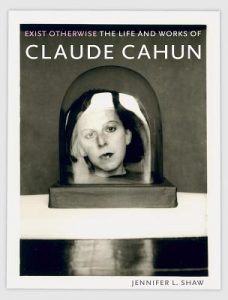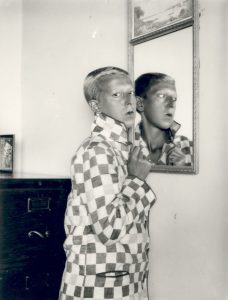 Exist Otherwise: The Life and Works of Claude Cahun
Exist Otherwise: The Life and Works of Claude Cahun
by Jennifer L. Shaw
Reaktion. 256 pages, $45.
CLAUDE CAHUN may not be particularly well known outside the art world, but this highly readable biography of the 20th-century French writer, artist, and photographer ought to help change this situation. Jennifer L. Shaw has written a fascinating book about a gender-bending lesbian intellectual who challenged ideas of gender and sexuality in both her life and art.
Claude Cahun (1894-1954) led a highly unconventional life. Lucy Schwob, her original name, was born into a prominent, well-off publishing family in Nantes. She was relentlessly bullied in school for her bookishness and her family’s Jewish heritage, so much so that she temporarily transferred to England. Her mother suffered from mental illness and was frequently institutionalized. As a teenager, she met and befriended Suzanne Malherbe, who would become her lover, stepsister, and artistic collaborator under the name Marcel Moore. Schwob later adopted the pen name Claude Cahun, moved with Moore to Paris, and became deeply involved in the cultural and intellectual life of the city, delving into theater, the Surrealist movement, and politics. The two women met people like Sylvia Beach, André Breton, and Salvador Dalí. Shortly before World War II, they moved to Jersey (the island), and during the German occupation of the island, they engaged in an artistic resistance that lead to their imprisonment and nearly to their execution.
From Shaw’s viewpoint, Cahun’s artistic output emerged from her sense of being different—as a woman, a lesbian, and a Jew. Her first serious attempt at a book-length literary work, the unpublished “Les Jeux Uraniens” (“Uranian Games”), was about a number of Victorian poets who wrote about homosexuality, among them Oscar Wilde and his lover Alfred Douglas. The book includes a dialogue between personifications of sexual love and spiritual love. A collection of essays, Heroines (1925), rewrites the classic tales of women like Eve, Sappho, Cinderella, and Belle (of Beauty and the Beast) to reshape them into “self-possessed, shrewd and knowing characters.” For instance, Belle “feels cheated” when the monster becomes a prince, since she has spent time and energy learning to love his monstrous qualities. She asks him for “the address of ‘an authentic monster,’ one who might be able to fulfill her desire.” Another work, Disavowals, has as its epigraph: “Surely you are not claiming to be more pederast than I?”

Her photography takes this critique of femininity and heterosexuality to another level. Her persona in many of her photos is what today might be called “genderqueer,” with shaved head and gender-neutral clothing. In some, she poses as the Buddha wearing traditional garb. The cover photograph for this book displays her disembodied head in a jar; it is one of a series of similar photographs. Later images are photomontages that, as Shaw writes, enable viewers “to think critically about … conventions of gender, sexuality, creativity and love.” They seem very much in line with Surrealism, and can still surprise us even today.
Cahun was also involved with the French Communist Party, although it was a complicated relationship, for her and many other artists. While she was uncomfortable with the Communist insistence on social realism, preferring to take “her own individual position on art,” she always remained interested in Marxist thought. Her activities in Jersey during the war, creating subversive photomontages to be found by the German forces, can be said to combine her artistic and political interests. This section of the book is incredibly suspenseful, as she and Moore truly risked their lives for their art.
Filled with reproductions of photographs and detailed descriptions and analyses of her writings, Exist Otherwise is a comprehensive introduction to Claude Cahun’s art and writing. With any luck it will bring readers back to her unique body of work.
Charles Green is a writer based in Annapolis, Maryland.






